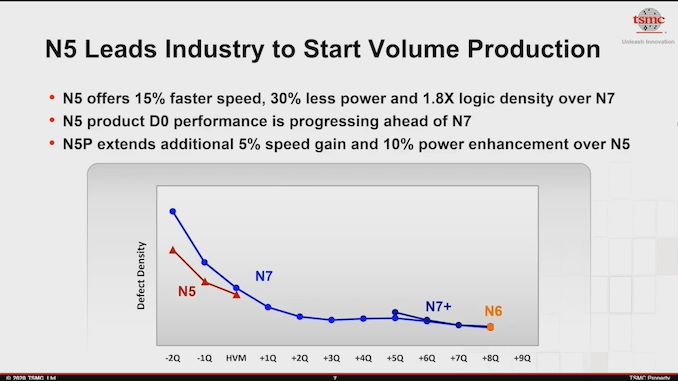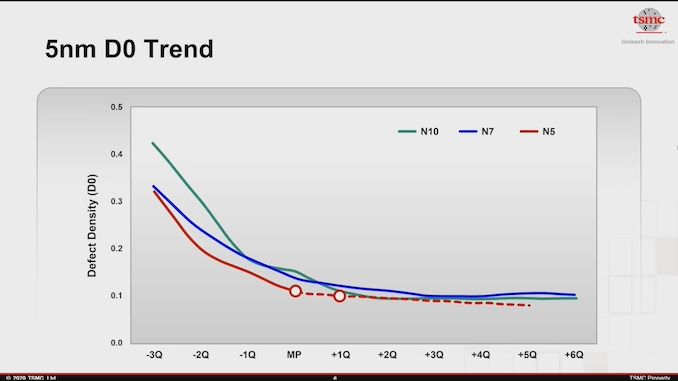‘Better Yield on 5nm than 7nm’: TSMC Update on Defect Rates for N5
by Dr. Ian Cutress on August 25, 2020 9:30 AM EST
One of the key metrics on how well a semiconductor process is developing is looking at its quantitative chip yield – or rather, its defect density. A manufacturing process that has fewer defects per given unit area will produce more known good silicon than one that has more defects, and the goal of any foundry process is to minimize that defect rate over time. This will give the customers better throughput when making orders, and the foundry aims to balance that with the cost of improving the manufacturing process.
The measure used for defect density is the number of defects per square centimeter. Anything below 0.5/cm2 is usually a good metric, and we’ve seen TSMC pull some really interesting numbers, such as 0.09 defects per square centimetre on its N7 process node only three quarters after high volume manufacturing started, as was announced in November at the VLSI Symposium 2019. As it stands, the defect rate of a new process node is often compared to what the defect rate was for the previous node at the same time in development. As a result, we got this graph from TSMC’s Technology Symposium this week:
As it stands, the current N5 process from TSMC has a lower defect density than N7 did at the same time in its development cycle. TSMC. This slide from TSMC was showcased near the start of the event, and a more detailed graph was given later in the day:
This plot is linear, rather than the logarithmic curve of the first plot. This means that TSMC’s N5 process currently sits around 0.10 to 0.11 defects per square centimeter, and the company expects to go below 0.10 as high volume manufacturing ramps into next quarter.
Part of what makes 5nm yield slightly better is perhaps down to the increasing use of Extreme UltraViolet (EUV) technology, which reduces the total number of manufacturing steps. Each step is a potential chance to decrease yield, so by replacing 4 steps of DUV for 1 step of EUV, it eliminates some of that defect rate.
TSMC’s first 5nm process, called N5, is currently in high volume production. The first products built on N5 are expected to be smartphone processors for handsets due later this year.
Related Reading
- TSMC Details 3nm Process Technology: Full Node Scaling for 2H22 Volume Production
- TSMC To Build 5nm Fab In Arizona, Set To Come Online In 2024
- TSMC & Broadcom Develop 1,700 mm2 CoWoS Interposer: 2X Larger Than Reticles
- TSMC Boosts CapEx by $1 Billion, Expects N5 Node to Be Major Success
- Early TSMC 5nm Test Chip Yields 80%, HVM Coming in H1 2020
- TSMC: 5nm on Track for Q2 2020 HVM, Will Ramp Faster Than 7nm
- TSMC: N7+ EUV Process Technology in High Volume, 6nm (N6) Coming Soon












102 Comments
View All Comments
RSAUser - Tuesday, August 25, 2020 - link
TSMC announced it in 2016, Risk production was 2017, high volume was started in April 2018, not sure where you're getting your dates from.JayNor - Tuesday, August 25, 2020 - link
Intel should be able to outbid AMD for TSMC wafer starts. In fact, Xe-HPG is already in the lab.psychobriggsy - Tuesday, August 25, 2020 - link
It's not all about money. AMD are a dedicated TSMC-only customer right now, whereas Intel are a high risk of only being a fly-by customer until they sort their own issues out. That factors heavily into allocation decisions.AnGe85 - Wednesday, August 26, 2020 - link
According to Bloomberg, Intel has ordered 180,000 wafers in N6 for 2021. To bring this in context, they also stated that AMD had a 7 nm volume of about 200,000 wafers in 2019 at TSMC.Spunjji - Wednesday, August 26, 2020 - link
I'm not sure that does necessarily bring things into context, though - we'd need to see AMD's 2021 numbers for 7nm and 5nm. They've done a fair bit of growing since 2019.Eneq - Saturday, August 29, 2020 - link
Also remember that Intel die size is a lot larger so the volume per wafer is less.hululu - Tuesday, August 25, 2020 - link
TSMC would not kill its golden goose.canukstorm - Tuesday, August 25, 2020 - link
TSMC's golden goose is Apple, not AMDTimSyd - Tuesday, August 25, 2020 - link
Nah. AMD has more wafer volume & spends more at TSMC that Apple - do the math on AMD's multiple hi-volume products per technology node (3-5 different APU's & counting, CPU chiplets, GPU's etc) vs Apples single/dual product per node (iPhone & iPad).Though of course Apple's aggressive SoC roadmaps help TSMC learn & pay for initial node ramps at each technology generation :)
melgross - Tuesday, August 25, 2020 - link
Where did you get that information from? It’s very doubtful. Apple buys well over 200 million chips a year from TSMC. Additionally, TSMC receives equipment from Apple.